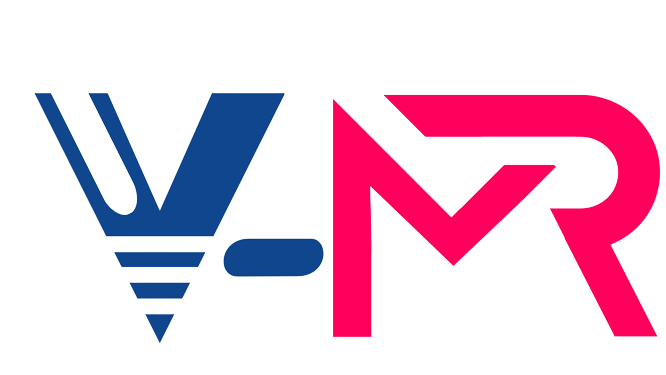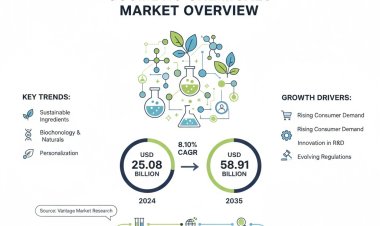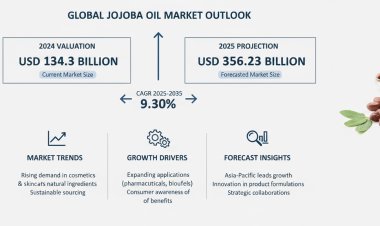Weight Loss Drugs Market Size, Trends, and Forecast 2025-2035
Explore the Weight Loss Drugs Market from 2025 to 2035, featuring insights on market dynamics, competitive landscape, segmentation, and future outlook. Discover how obesity trends and pharmaceutical innovations shape this industry.

Weight Loss Drugs Market Size and Forecast
The worldwide market for weight loss drugs is rapidly expanding, fueled by rising obesity rates and a changing perception of obesity as a chronic disease. The Global Weight Loss Drugs Market is expected to be valued at USD 2.88 billion in 2024. It is projected to reach USD 142.5 billion by 2035, growing at a compound annual growth rate (CAGR) of 42.5% during the forecast period from 2025 to 2035, according to data from Vantage Market Research. This moment is both indicative of a new era in the weight loss pharmaceutical space, one in which the convergence of pharmacological, patient-centered therapeutic, and technological advancements will drive the market.
Download Sample Report PDF (Including Full TOC, Table & Figures) @ https://www.vantagemarketresearch.com/weight-loss-drugs-market-4242/request-sample
Obesity, classified as a chronic disease by the WHO, is a global health problem as it affects more than 650 million adults globally. It is closely linked to comorbidities such as diabetes mellitus, cardiovascular disorders, and hypertension, which are a significant burden on healthcare systems globally. For many people, traditional methods of weight management, such as dietary changes and exercise, do not yield practical benefits. Thus, there has been a steady increase in the demand for pharmacological interventions to aid in weight management.
Weight loss medications work in different ways, most of which are appetite control, fat absorption inhibition, or the rate of metabolism. Some of the most prominent medications include the class of drugs called GLP-1 (glucagon-like peptide-1) receptor agonists, such as Wegovy (semaglutide) from Novo Nordisk and Zepbound (tirzepatide) from Eli Lilly. These drugs have changed the landscape of obesity treatments as they are more effective than conventional weight loss drugs. Additionally, emerging combination therapies and personalized medicine are ushering in novel avenues in the development of weight loss therapies.
More recently, there has been a shift away from oral drugs towards more efficacious biologics, such as injectable GLP-1 drugs, and the early integration of digital health technologies. Mobile apps and telemedicine platforms are also being increasingly used to monitor patient compliance and encourage weight loss. But progress has not been without its problems, particularly when it comes to the adverse side effects of some medications, and the costs of prescription drugs can be restrictive for poorer demographics.
Geographically, North America remains the largest market segment, driven by the high prevalence of obesity and a well-established healthcare infrastructure. On the other hand, countries in the Asia-Pacific region are experiencing rapid growth, aided by a rising, large middle-class population and a growing awareness of health risks associated with obesity. The weight loss drugs market is expected to continue growing in the years to come, driven by global health issues related to obesity, which will inspire innovations in future weight loss medications.
Our comprehensive Weight Loss Drugs Market Report is now available, featuring the latest trends, growth opportunities, and strategic analysis. View Sample Report PDF.

Market Dynamics
Drivers:
Obesity has steadily been increasing, with over 30% of the overall global population considered overweight or obese. Obesity has become a growing concern across the globe, with developed parts of the world, like North America and Europe, facing some of the biggest problems. The growing obesity epidemic is stimulating the need for efficacious interventions, including pharmacological measures, for weight loss.
Drugs that were previously thought to be effective were discovered to have higher burnout in a particular group due to their implication in large-scale biological and technological developments. In the context of GLP-1 (glucagon-like peptide-1) receptor agonists, semaglutide and liraglutide have specifically been shown to have large effect sizes regarding weight loss due to their influence on appetite and satiety. Then there are dual-target drugs, such as tirzepatide, drawing interest for their capacity to target two weight-regulating pathways- and produce superior results.
Regulatory Support for Weight Loss Drugs — The U.S. Food and Drug Administration (FDA) and other regulatory bodies are increasingly approving weight loss drugs that demonstrate cardiovascular benefits, greatly incentivizing pharmaceutical companies to invest in obesity treatment development. This has led to an accelerated process for bringing new and improved therapies to market.
Health consciousness - The increasing availability of information and knowledge about the comorbidities associated with obesity, such as diabetes, hypertension, and heart disease, has made health consciousness a global phenomenon. Consequently, preventive medicine is gaining traction, including pharmaceutical solutions for weight loss.
Restraints:
The side effects of weight loss drugs - Many weight loss drugs have shown effectiveness, but side effects are a big concern. Some common side effects are gastrointestinal problems, nausea, and sometimes heart issues. As a result, the effectiveness of the drugs is limited by the decreased patient adherence to treatment regimens due to these side effects.
The High Price of Weight Loss Drugs - Drugs such as Wegovy® and Ozempic® can come with a price tag of over $1,000/month, out of reach of large segments of the global population. High prices of drugs present a barrier to access in low-income and developing countries, where access to these treatments is limited.
Stigma Around Weight Loss Drugs - Not every obesity is considered a disease, and there may be some stigma attached to the use of weight loss drugs. These drugs are often perceived as a “quick fix” rather than a long-term solution, which can prevent them from gaining wide acceptance.
Opportunities:
Emerging Markets - The rising rates of obesity in emerging markets, such as those in the Asia-Pacific and Latin America regions, present a significant growth opportunity for the weight loss drugs market. Growing disposable incomes and a rising middle class are increasing the demand for effective solutions to weight loss.
Patient Monitoring Technology - Recent advances in wearable devices and mobile apps for monitoring physical activity and dietary habits also enhance patient engagement with weight loss treatments. Pharmaceutical interventions promote health and prevent disease, and their effects could be supplemented with digital health tools for continued monitoring and personalized recommendations.
OTC (Over-the-Counter) Weight Loss Drugs - An increased focus on OTC weight loss drugs, particularly among patients classified as Class I or Class II (according to the WHO obesity classification). At the same time, there are OTC products, such as Alli (orlistat), which offer a lower-cost alternative to prescription drugs and help expand the weight loss treatment marketplace.
Challenges:
Regulatory Hurdles - Obtaining approval for a weight loss drug from regulatory agencies is a lengthy and complex process that necessitates extensive data on safety and efficacy. Regulatory bottlenecks often stall market access for innovative drugs.
Non-Pharmaceutical Alternatives (i.e., Weight Loss Surgery, Wellness Programs, Lifestyle Interventions)- These non-pharmaceutical approaches are still competing with weight loss drugs, especially among patients seeking holistic or surgical interventions.
Take Action Now: Secure your Global Weight Loss Drugs industry today – Purchase Now
Competitive Landscape
The landscape for weight loss drugs is highly competitive, featuring numerous major players, including large pharmaceutical companies, emerging biotech firms, and over-the-counter (OTC) product manufacturers. Novo Nordisk, Eli Lilly, and Pfizer are among the leading pharmaceutical companies developing prescription weight loss drugs, specifically the GLP-1 receptor agonists. Some of the biggest drugs currently being marketed include Novo Nordisk’s Wegovy and Eli Lilly’s Zepbound, and their success has fueled expansion in the space as a growing number of medications have been highly effective and cost-effective in managing weight.
In addition to the major players in the prescription drug market, the OTC weight loss drug segment is also fragmented, with a multitude of herbal and natural supplements, fat binders, and appetite suppressants competing for shelf space. Brands such as Alli® have found their place on OTC shelves as low-cost alternatives to prescription-strength weight-loss drugs.
This suggests a growing interest in research and development investment as well as strategic collaboration in the market. Pfizer is developing oral formulations of GLP-1 agonists to compete with injectable options, while Roche is exploring combination therapies that can address metabolic diseases. Similarly, collaborations between pharmaceutical companies and digital health platforms continue to gain ground as a way to enhance patient adherence and fine-tune treatment outcomes.
Key players in the market include:
- Novo Nordisk: A leader in the GLP-1 receptor agonist segment, holding a significant market share with Wegovy®.
- Eli Lilly: Known for its dual GIP/GLP-1 drug, Zepbound™, approved in 2023.
- Pfizer: Developing oral GLP-1 alternatives to compete with injectable therapies.
- Roche: Focusing on combination therapies for obesity and metabolic diseases.
These companies are driving market growth through heavy R&D investments and the introduction of innovative treatments that combine pharmaceutical and digital health technologies.
Segment Overview
Several segments of the weight loss drugs market could be categorized as follows:
- By Drug Type: Prescription drugs (e.g., Wegovy®, Saxenda®) hold the major share of the market, owing to their greater efficacy. OTC weight loss drugs (e.g., Alli®) represent a smaller share but are growing in popularity due to low costs and convenience.
- By Route of Administration: Currently, injectables occupy a larger market of ~60 % due to their higher efficacy in treating severe obesity. Oral formulations are, however, increasingly popular due to their ease of use.
- By Mechanism of Action: Appetite suppressants are the most common mechanism of action, followed by fat absorption inhibitors and metabolic rate enhancers. Combination drugs with multiple mechanisms are also emerging.
- By Patient Type: The large majority of weight loss drug consumers are (BMI ≥30) obese people, but drugs for overweight people and those with weight-related health problems are also gaining ground.
- By Distribution Channel: Retail pharmacies and hospital pharmacies are the primary channels, while online pharmacies have experienced rapid growth in recent years, particularly following the pandemic.
- By region: North America has the highest market share, followed by Europe. Then again, the Asia-Pacific region is expected to show the highest growth rate due to rising obesity levels and increasing access to healthcare.
Segmentation and Targeting
On the other hand, pharmaceutical corporations are employing an increasingly targeted marketing strategy to resonate with specific patient demographics, such as:
- Demographic: Women aged between 35-55; the largest consumers are attracted by safety reasons, with obesity being common in this Demographic.
- Geographic: Cities with high rates of obesity, especially in North America & Gulf countries.
- Behavioral: Patients who demonstrate digital engagement, utilize telehealth services, and explore subscription models (such as weight loss treatments) are emerging as a key target audience.
- Clinical: In the Altenburger concept of physicians, whereas an FDA guideline establishes the FDA approach, the BMICL guideline recommends action for physicians with a BMI ≥30 and those with a BMI≥27 and comorbidities.
For the Weight Loss Drugs Market Research Report and updates, view the full report now!
Future Outlook
The global weight loss drugs market is expected to remain a major player in the global market. The global weight loss drugs Industry is expected to reach USD 142.5 billion by 2035, driven by ongoing innovations in drug formulations, the growing emergence of new markets, and the advent of personalized medicine. This need for accessibility can be addressed through the integration of digital health and pharmacological treatment; however, the future lies in AI-driven algorithms for personalized treatment plans. Yet, it faces challenges such as pricing pressures and regulatory scrutiny of advertising that could affect its growth. While the fear of the unknown has been temporarily disrupted, new treatment and access options will help this market continue its growth if market strength is maintained.
FAQ.
- What are weight-loss drugs, and how do they work?
- Answer: Weight-loss drugs are medications designed to help individuals lose weight by promoting fat loss or suppressing appetite. They work through various mechanisms, such as suppressing appetite (anorectics), inhibiting fat absorption, boosting metabolism, or regulating hormones that control hunger and satiety. Popular types include GLP-1 receptor agonists, such as semaglutide (Wegovy®), which has shown significant efficacy in weight management.
- How effective are weight-loss drugs?
- Answer: The effectiveness of weight loss drugs varies depending on the medication. For example, GLP-1 receptor agonists, such as Wegovy, can lead to an average weight loss of approximately 15-20% of body weight in clinical trials. However, results vary from person to person, and these medications are most effective when used in conjunction with a balanced diet and regular exercise. Non-prescription drugs, such as orlistat (Alli), may result in more modest weight loss.
- What are the most commonly prescribed weight loss drugs?
- Answer: The most commonly prescribed weight loss drugs include:
- Wegovy® (semaglutide) – A GLP-1 receptor agonist that significantly reduces appetite and food intake.
- Saxenda® (liraglutide) – Another GLP-1 receptor agonist used for chronic weight management.
- Contrave® (naltrexone-bupropion) – A combination drug that affects the central nervous system to reduce hunger and cravings.
- Qsymia (phentermine-topiramate) – A combination of the appetite suppressant phentermine and the anti-seizure drug topiramate.
- What are the side effects of weight-loss drugs?
- Answer: Common side effects of weight-loss drugs include gastrointestinal issues like nausea, diarrhea, and constipation, particularly with drugs like orlistat and GLP-1 receptor agonists. There are also potential cardiovascular side effects, especially with stimulant-based medications. For drugs like Saxenda® or Wegovy®, some individuals may experience headaches, dizziness, or fatigue. Serious side effects are rare but can include issues like pancreatitis or gallbladder problems.
- Are weight-loss drugs safe for long-term use?
- Answer: Many weight-loss drugs have been shown to be safe for long-term use when prescribed by a healthcare provider and monitored regularly. Drugs like Wegovy® and Saxenda® have been approved for chronic use in obesity management. However, long-term safety depends on individual health conditions, and patients should be closely monitored for any adverse effects that may develop over time.
- Who Should Use Weight-Loss Drugs?
- Answer: Weight loss drugs are generally recommended for individuals with a BMI of 30 or higher (obesity) or for those with a BMI of 27-29.9 who also have obesity-related conditions, such as type 2 diabetes, hypertension, or high cholesterol. A healthcare provider typically evaluates a person's candidacy for weight loss medications based on their health status, weight loss goals, and the presence of other health conditions.
- How much do weight-loss drugs cost?
- Answer: The cost of weight-loss drugs can vary significantly. For example, drugs like Wegovy® can cost around $1,300 per month, while medications like Saxenda® can cost approximately $1,000 per month. Generic or over-the-counter options, such as orlistat (Alli®), are less expensive but may offer fewer benefits. Insurance may cover some prescription weight loss medications, particularly if the patient has comorbidities such as diabetes.
- Are there any over-the-counter weight loss drugs?
- Answer: Yes, over-the-counter (OTC) weight loss drugs do exist. The most common over-the-counter (OTC) weight loss drug is Orlistat (sold as Alli), which works by inhibiting the absorption of dietary fats in the digestive tract. While OTC options are more affordable, they tend to be less effective than prescription medications, especially for individuals with higher levels of obesity.
- Can weight-loss drugs be used without a doctor's prescription?
- Answer: Most weight loss drugs require a doctor’s prescription due to the potential for side effects, contraindications with other medications, and the need for professional oversight. However, there are some OTC weight loss options available that don’t require a prescription. It's important to consult with a healthcare provider before starting any weight loss medication to ensure it’s safe and appropriate for individual health conditions.
- What is the future outlook of the weight loss drugs market?
- Answer: The weight loss drugs market is expected to grow significantly in the coming years, driven by the increasing prevalence of obesity, advancements in drug development, and greater awareness of the health risks associated with obesity. The market is likely to see innovations in biologics, personalized medicine, and the integration of digital health tools for monitoring and improving treatment adherence. Additionally, emerging markets in regions such as the Asia-Pacific and Latin America will contribute to the market's expansion as disposable incomes rise and health awareness increases.


















